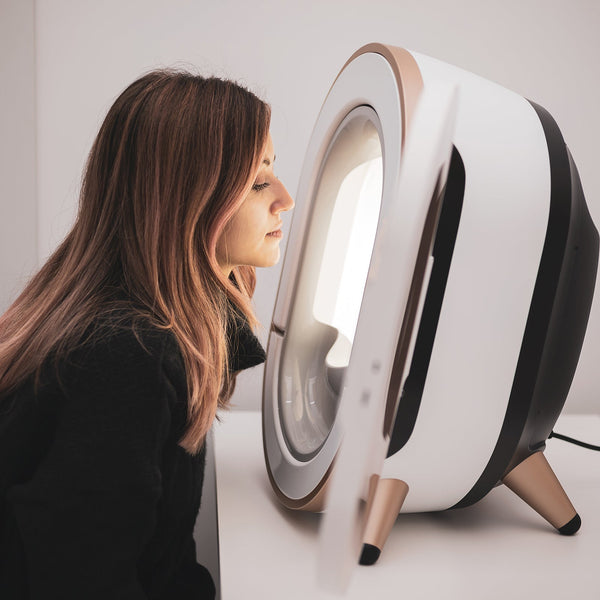Exploring Advanced Skin Analysis Tools for Estheticians

The beauty industry, expected to reach a global value of $677 billion in 2025, is undergoing a major transformation with the rise of ultra-personalized skincare. The era of “one-size-fits-all” skincare is fading, making way for more tailored solutions that cater to today’s well-informed consumers. As the beauty industry adapts to evolving demands, hyper-personalization is becoming a driving force across sectors. Research indicates that genetics, environment, and lifestyle play a significant role in skin health, leading consumers to seek estheticians who offer personalized treatments rather than one-size-fits-all facials. No two clients’ skin is the same, and one of the best ways to create a customized plan is by utilizing a skin-analyzer device.
Since every professional skincare treatment begins with a consultation, many skincare experts rely on diagnostic tools to assess the skin thoroughly. These devices allow for a deeper analysis, revealing underlying concerns that may not be visible to the naked eye.
Magnifying Lamp
A magnifying lamp is a fundamental diagnostic tool that combines 5-diopter magnification with LED lighting, enabling close-up skin examinations. It helps estheticians detect fine details such as small blemishes, pores, and ingrown hairs that may be difficult to see with the naked eye. While I don’t typically use magnifying lamps for skin consultations, I find them particularly useful for extractions and eyebrow shaping.
One limitation of magnifying lamps is that they only provide a visual inspection without offering deeper insights or data on skin health. However, they are an affordable option compared to more advanced diagnostic devices, making them a common fixture in many treatment rooms. The average cost ranges from $100 to $250. Personally, I use a magnifying lamp that attaches to my trolley, which helps keep the floor clear of additional caster “feet.”
Skin Analyzer
While some estheticians use magnifying lamps for basic assessments, an increasing number are turning to advanced analyzers like VISIA® for more precise evaluations. Skin analysis systems utilize multi-spectral imaging and sophisticated algorithms to assess skin health and appearance. By capturing high-resolution images under various lighting conditions, they evaluate multiple skin attributes. Canfield’s VISIA® system, a leader in the field, employs cross-polarized and UV lighting to examine both surface-level and deeper skin conditions. According to their website, VISIA® distinguishes red and brown skin components, offering unparalleled visualization of concerns such as spider veins, hyperpigmentation, and erythema. The system also assesses wrinkles, pore size, texture, and overall skin health, even estimating the skin’s age. One of its most valuable features is its ability to generate quantitative data, providing precise measurements of skin conditions and tracking progress over time. From my experience, these reports help clients gain a clearer understanding of their skin, leading to more informed decisions about treatments and product choices.
AI Technology
As personalized skincare solutions and hyper-detailed skin analysis gain momentum, AI-driven technologies are starting to transform the industry. This trend has paved the way for companies to introduce cutting-edge additions to the US market. I wanted to learn as much as possible about AI-driven skincare innovations, so I sat down to interview Val Neicu, the co-founder and CEO of SmartSKN, the innovative company bringing Korean personalized skincare to the US market. SmartSKN has entered into a partnership with the technology’s maker, LillyCover that grants SmartSKN the exclusive rights to introduce LillyCover’s AI-driven skin analysis devices and on-demand K-beauty skin care production robots to US consumers.
Val was generous enough to send me one of her Muilli portable skin analyzer tools to “play” with. The device is as small as a flashlight, but its database is trained on 150,000+ diverse skin profiles worldwide. Muilli uses 60x magnification to capture high-resolution images of your client’s skin, providing a detailed view of its condition at a microscopic level. Its bioimpedance sensor measures the client’s skin's moisture and oil levels, giving the esthetician a precise understanding of the client’s hydration and oil balance.
The device connects to your phone through a secure WI FI connection, and you see the camera view from the thermoscope in real-time on your phone or tablet. After the scan with the Muilli Dermascope, you are directed to the SmartSKN website, where you will see the products recommended by the AI. There are three products that SmartSKN robots currently make, all in 30ml size – the lotion, the essence serum, and the ampoule. The esthetician may send the link to the client, and all he or she has to do is check out and pay within 30 days. The esthetician gets a commission from the sale, and after the robot makes the products, it’s drop shipped directly to the client.
Today, the future of skincare appears to be a balanced blend of technology and touch. By integrating innovative tools with thoughtfully customized treatments, skincare professionals can adapt to clients’ evolving needs and build meaningful and lasting relationships. Estheticians who embrace this balance between technological advancements and personal connection stand to change the landscape in skin health, positioning themselves at the forefront of an industry that values both progress and trust.









